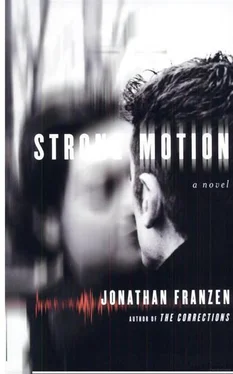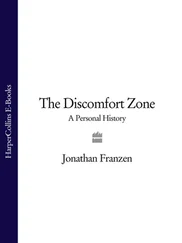He was traveling a parkway in Everett or Medford (he wasn’t exactly sure which) when lights came on and it became apparent that the city and the inner suburbs were far from fully wrecked. A number of houses had dropped to their knees or lost walls, but even the worst streets looked better than an average ghetto block. Irish youths were milling on the roof of a ball-field dugout, drinking beer. Children were playing in the restored light the way children of the desert play in rainstorms. He let himself relax a little, and immediately felt sick with exhaustion and the abject regret that staying up all night had always caused him.
The sky was pink and yellow when he reached Back Bay. Unreality still adhered to the various fixtures from which destruction had emanated — to the buckled sidewalk, to the wet crack angling across Marlborough Street, to the loose bricks and cast concrete finials and chunks of masonry that lay on the grass or pavement with pointed, disingenuous motionlessness, as if hoping to pass as fragments of a Roman temple or boulders at the bottom of a cliff, things that hadn’t budged in centuries. Eileen and Peter’s building, however, was standing just the way Louis had left it.
At Brigham & Women’s a few stragglers, most of them old, sat unmoving outside the emergency room, trying just to be objects until a doctor could turn them back into people with testimony, stories. Broken bottles and fallen tiles had been swept into tidy heaps, and the nurses were brisk and unpanicked. A familiar one sent Louis to the bed where Renée, he saw, was sleeping.

All Monday, all Tuesday, the earthquake held the country hostage. Giant headlines marching in lockstep like fascist troops booted everything else off the face of front pages, and in the afternoon people trying to watch soap operas were subjected to special reports instead. Major-league baseball canceled two nights’ worth of games in case fans had any ideas of taking refuge from the news in balls and strikes. Even the Vice President was forced to cut short his swing through Central American capitals and fly to Boston.
It’s not pleasant to be held hostage; it’s not just a figure of speech. In a decadent society people can slowly drift or slowly be drawn by the culture of commerce into yearning for violence. Maybe people have a deep congenital awareness that no civilization lasts forever, that the most peaceful prosperity will someday have to end, or maybe it’s just human nature. But war can begin to seem like a well-earned fireworks display, and a serial killer (as long as he’s in a distant city) like a man to root for. A decadent society teaches people to enjoy advertisements of violence against women, any suggestion of the yanking down of women’s bra straps and the seizing of their breasts, the raping of women, the tying up of women’s limbs with rope, the puncturing of women’s bellies, the hearing of their screams. But then some actual woman they know gets abducted and raped and not only fails to enjoy it but becomes angry or injured for a lifetime, and suddenly they are hostages to her experience. They feel sick with constriction, because all those sexy images and hints have long since become bridges to span the emptiness of their days.
And now the disaster which had been promising to make you feel that you lived in a special time, a real time, a time of the kind you read about in history books, a time of suffering and death and heroism, a time that you’d remember as easily as you’d forget all those years in, which you’d done little but futilely pursue sex and romance through your purchases: now a disaster of these historic proportions had come, and now you knew it wasn’t what you’d wanted either. Not this endless endless televised repetition of clichés and earnest furrowings of reportorial brows, not these nightmare faces of anchorpeople in pancake staring at you hour after hour. Not this footage of the same few bloody bodies on stretchers. Not this sickening proliferation of identical newspaper articles running identical interviews with survivors who said it was scary and identical statements from scientists who said it was not well understood. Not these photos of buildings that were damaged but not obliterated. Not this same vision, over and over, of the smoking ruin in Peabody on which an ordinary morning sun shone because the sun still rose because the world wasn’t changed because your life wasn’t changed. You would have preferred the more honest meaninglessness of a World Series, the entertainment of an event towards which months of expectation and weeks of hype could build, bridging a summer and fall’s emptiness and producing, in conclusion, an entirely portable set of numbers which the media couldn’t rub your face in for more than about an hour. Because you could see now that the earthquake was neither history nor entertainment. It was simply an unusually awful mess. And although the earthquake too could be reduced to a score — injuries 1,300, deaths 71, magnitude 6.1—it was the kind of score that your righteous captors felt justified in repeating until you went insane and dissolved in screams which they, however, behind their microphones and computer monitors, didn’t hear.
The picture that made Monday evening’s front pages around the world showed the ruins of Sweeting-Aldren’s facilities in Peabody. Twenty-three of the deaths and 110 of the injuries had been suffered by company employees caught in the initial explosion of two process lines and the ensuing general conflagration. The earthquake had disabled various fire-control systems, and balls of combusting ethylene and sheets of flaming benzene had ignited storage tanks. A blast apparently caused by ammonium nitrate leveled process lines that otherwise might not have burned. White clouds rained nitric acid and hydrochloric acid and organic reagents, the hydrocarbons and halogens combining in an environment as high-temperature and low-pH as the surface of Venus, but considerably more toxic. Cooling and drifting, the vapor plume descended on residential neighborhoods and left a whitish, oily residue on everything it touched.
By Monday afternoon EPA officials in Mylar suits were measuring dioxin levels in the parts-per-hundred-thousand on streets immediately to the north of the installation. Birds littered the ground beneath trees like fallen, mold-cloaked fruit. Cats and squirrels and rabbits lay dead on lawns or convulsing and retching under hedges. The weather was lovely, temperature in the high seventies, humidity low. National Guard units in tear-gas gear worked methodically northward, evacuating recalcitrant homeowners with force when it was necessary, barricading streets with Warning Orange barrels, and encircling the most contaminated area, designated Zone I, with flimsy orange plastic fencing material that had apparently been stockpiled with this very purpose in mind.
By Tuesday evening, Zone I had been completely isolated. It consisted of five and a half square miles of gravel pits, shabby residential streets, trash-glutted wetlands, and some worn-out factories owned by companies that had long been scaling back. Already several Peabody residents who had been at home when the plume descended were in the hospital, complaining of dizziness or extreme fatigue. The houses they’d left behind, now visitable only by National Guard patrols and news teams, had the aspect of junked sofas — the bad legs, the weakened joints, the skins torn here and there to expose an internal chaos of springs and crumbled stuffing. Earthquake damage was similar in the much larger Zone II to the north, but here the contamination was spotty and ill defined enough that the Guard was letting adult residents return during daylight hours to secure their houses and collect personal belongings.
Читать дальше
Конец ознакомительного отрывка
Купить книгу













